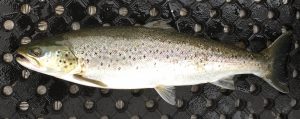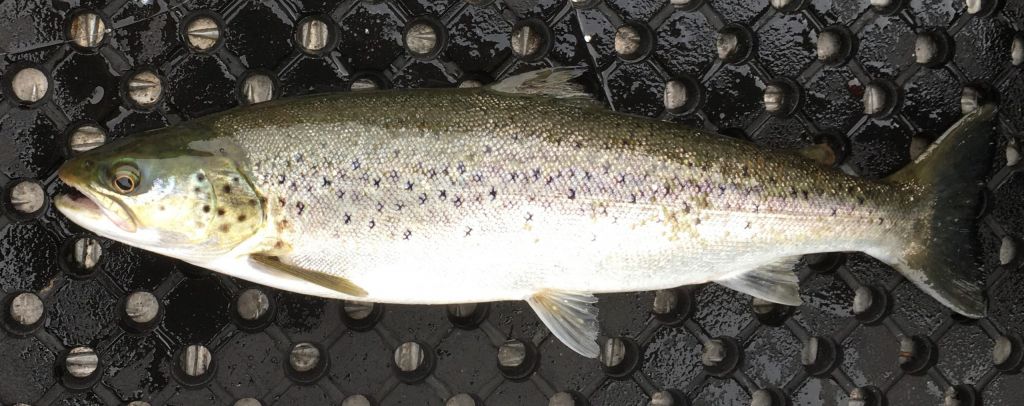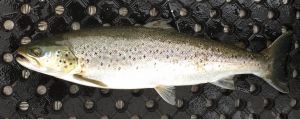Taking stock: One of my correspondents sent me a link to the latest Speyonline blog by angling guide Ian Gordon. The blog is about restocking and the success of a restocking strategy on the west coast River Carron. However, the blog also points out that ‘the people at Marine Scotland Science have done everything in their power to ensure no successful restocking programme can possibly take place in Scotland.’ Yet Bob Kindness from the River Carron has shown that ‘if done properly then the restocking of salmon is both justifiable, affordable and effective’.
I wholeheartedly agree.
The blog makes interesting reading, but I am not going to discuss the issues raised here. I have written about Bob and the River Carron Restoration Programme a number of times so I would simply encourage you to read the blog at: https://www.speycaster.co.uk/post/of-course-my-hatchery-works?utm_campaign=9ff2b1d8-73ad-4089-8d4b-51ae9fafb827&utm_source=so&utm_medium=mail&cid=cd8286fc-02b8-4513-8793-637f73fe771c
Unusually, I would like to declare an interest in this discussion, not just because I have known Bob for many years and not because last year I was invited to visit the Freshwater Fisheries Laboratory at Pitlochry at their expense to be ‘informed’ about their new restocking policy. I am still unsure why I was invited to hear about restocking of wild fisheries other than there was concern that I might raise the issue in the reLAKSation viewsletter. The reality is that I didn’t have a view because my interest in wild fisheries relates only to the readiness of the sector to blame aquaculture for declining fish stocks when clearly there is no salmon farming in the areas where most wild salmon are caught.
However, as the details of the new stocking policy was revealed, the more I realised that it was completely out of touch with reality. I raised the success of the River Carron Restoration Programme after I was told that restocking does not work. In response I was reliably informed that the River Carron would have recovered naturally irrespective of Bob’s work. It is only necessary to look at the catch data from the Carron to recognise that the catches have greatly exceeded anything that came before.
However, the flaw in the new policy relates to the difference in restocking for conservation or mitigation and restocking for angling. In effect, the only restocking that will be approved will be that for conservation purposes. Restocking aimed at improving the angling will not be allowed. The stocking policy can be viewed at https://www2.gov.scot/Topics/marine/Licensing/fishintros/introduction/SalmonStockingPolicy
In my opinion, Marine Scotland Science have become confused by conservation and angling. In their leaked document, even the Atlantic Salmon Trust, whose moto is ‘Putting Wild Salmon First’ admit that anglers have been the main driver behind wild salmon conservation. In fact, without anglers, no-one would be talking about salmon conservation at all. Salmon conservation and salmon angling are inextricably linked together. The whole point about conservation policy is about providing wild salmon for anglers to catch so it would make sense that if ‘salmon conservation’ is the priority then all exploitation should be banned. If on the other hand, salmon fishing is important, then any way to boost stocks must be encouraged. Off course the problem is that in attempting to discredit salmon farming, hatcheries and artificial breeding have been portrayed as damaging to the stock. Even MSS say this in their policy document. They express concern about introgression, inbreeding, and that fish are of local origin from the same river or same sub-catchment.
Of course, it wasn’t always so. As long ago as 1890, there were 18 hatcheries operating in Scotland. Their popularity ebbed and flowed with changing numbers of returning salmon. However, over the years there has been widespread stocking of eggs or fry from other rivers than the river being stocked. One of the most publicised restocking ventures has been the River Tyne in northern England. The initial stocking of 55,000 local ova was supplemented with 350,000 ova from both the west and east coast of Scotland. It was claimed that this mix of eggs facilitated the recovery of the river. The Tyne experiment is the subject of a book – Swimming against the Tide. Restoring salmon to the Tyne by Michael Gray. Since his death, there has been a lot of criticism of his work and unfortunately he is no longer here to defend himself.
What is interesting about the Tyne restocking programme is that it began in the late 1970s and then there were no concerns about using eggs from other rivers for restocking. It took something unique to bring about the idea that mixing eggs from different sources was damaging. I expect regular readers of reLAKSation will know what I’m going to say next.
Of course, the idea of salmon stocks in individual rivers being genetically pure developed as a consequence of the advent of salmon farming. The fact stocks from different rivers had been intermixed for years was irrelevant.
Seemingly, I have an ally in the belief that genetic purity of stocks is a myth in Sir Michael Wigan, author of the book ‘The Salmon’. Whilst Sir Michael Wigan is highly critical of the salmon farming industry, he also is clear that genetic purity of stocks is a new mission for salmon theorists. He says that in Scotland (written in 2013) restocking is only allowed with stocks from that river.
Sir Michael argues that the genetic messiahs appear unable to deal with rivers such as my local river – the Mersey, which was recolonised by salmon estimated to come from 30 different rivers. He says that this can only have occurred by fish straying from one river to another and taking their genes with them. He goes on to say that straying is nature’s way of spreading risk whereas the reality it is about boosting the gene pool and preventing inbreeding. New genes can bring benefits to stocks but if they don’t, they will be quickly bred out.
This is the principle that those who criticise salmon escapes appear to ignore. If a wild salmon should breed with an escaped farm salmon, then the resulting genes are not fixed for ever. Anything that doesn’t benefit the fish will be bred out in future matings. The idea that salmon from different rivers are genetically distinct is just a way of attacking salmon farming. The £1 million FASMOP programme that took place around 2011 is now never mentioned, but this was supposed to identify distinct genetic populations in a number of different rivers and of course it didn’t, which is why it has been consigned to the historic waste bin where it has been long forgotten by those who have drawn up the new restocking policy.
Wild: I was sent this picture of a sea trout which was caught on Tuesday evening this week from a west coast sea loch and very near to an aquaculture facility.

This is one of two fish that were caught in a very short time. As is clear from the photo this sea trout is free of sea lice, which debunks the myth that sea trout are virtually extinct from the west coast and those fish that are still alive are riddled with sea lice. It is always interesting to hear from people on the ground because what they see and hear is often far removed from those who make decisions – as demonstrated by the restocking policy discussed above.
I mention this because many years ago there was a TV programme in which a management advisor, whose name escapes me, went into a number of companies and asked the staff who he said usually much more knowledgeable about the business than their managers, to reorganise the company to make it more effective. In every case, the companies were all much more productive much to the chagrin of the managers, who usually changed it back at a later date.
I often hear that the ghillies and river managers have a much better appreciation of their rivers than the scientists. This is probably true, but the scientists view seems to always prevail. Perhaps, the time has come to change the narrative and start listening in a much more open-minded way.
I mention this because my correspondent angler wanted to discuss some issues about sea trout with me. Andrew Graham Stewart of Salmon & Trout Conservation (who lives on the east coast) claims that salmon farming kills sea trout, so they never get to a larger size. By comparison, my correspondent who lives locally suggests that the genetics of these fish have been compromised because too many larger fish have been killed. This is similar to observations made for chinook salmon in North America where unselective harvesting has changed the age and size profile of the stock. The genetic pressure means that the fish breed earlier because growing to a larger size makes them vulnerable. There is some sense in this argument because if there are no large sea trout left on the west coast, then what is the parentage of the two sea trout caught this week? They must have been bred from smaller fish.
My angler correspondent also says that as sea trout are multi-spawning fish, it would make sense if the smaller fish were protected. He suggests some form of fin clipping or tagging that prevents the fish being killed if caught by angling. He also adds that he is seeing good numbers of healthy-looking sea trout at the moment and these should be protected (The fish pictured, and others were all returned). He caught another that sped off like a torpedo and straightened the hood. He said it was much larger.
Finally, he said that sensible action is needed rather than all this mudslinging. I can only agree.
Hateful: BBC News have reported the British Labour Party are the latest in a longline of advertisers to boycott Facebook over their failure to removed hateful material. Facebook has been accused of allowing racist, violent, and verifiably false content to run rampant on its platform. Facebook was initially aimed at students but since 2006, anyone aged over 13 could open an account. However, its use by the wider public has led to accusations it been home to fake news, conspiracy theories and hate speech.
This week, anti-salmon farm campaigner Corin Smith has claimed the good news that more people have engaged with his Inside Scottish Salmon Feedlots than the Scottish Labour Party, the Scottish Liberals and the Scottish Green Party combined. Mr Smith has provided an infographic that shows that Scottish Labour has had 4.3k hits, The Greens – 2.5K and the Liberals just 281. This compares with 7.3k for Mr Smith. Of course, Labour, Greens and Liberals are minor parties in Scottish politics, so he ignores the 309.5k hits for the SNP and 34.5k for the Scottish Conservatives.
Anyone can select data to support their view which is why Facebook is now largely ignored by many individuals and businesses. Most interactions are now carried out on other social media platforms which is why Facebook’s days like several other now defunct forms of social media, they have only a limited future.
Facebook probably suits Mr Smith’s view of salmon farming as being somewhat outdated and of dubious origin. Unfortunately, Mr Smith is very quick to use another Facebook feature which is to block those who disagree with his views. Otherwise, Mr Smith might get to hear the true facts about salmon farming instead of the nonsense he so readily peddles.


